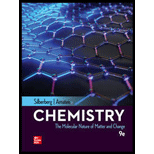
Concept explainers
(a)
Interpretation:
A balanced thermochemical equation for the formation of
Concept introduction:
Thermochemistry is the branch of chemistry which deals with the energy changes that occur in
The enthalpy of formation is defined as the amount of energy either absorbed or released during the formation of a compound. The enthalpy of a chemical reaction is the amount of heat either released or absorbed during a chemical reaction.
The general formula to calculate the enthalpy of reaction is,
The
(b)
Interpretation:
The minimum number of photons with
Concept introduction:
Energy is proportional to the frequency and is expressed by the Plank-Einstein equation as follows:
Here,
The equation to relate the frequency and wavelength of electromagnetic radiation is as follows:
The equation to calculate the energy of a photon is,
Here,
Want to see the full answer?
Check out a sample textbook solution
Chapter 7 Solutions
Chemistry: The Molecular Nature of Matter and Change
- 24) Who suggested the first model of the atom that included more than one orbit for electrons? Dalton a. b. Thomson C. Rutherford d. Bohr 25) Which of the following compounds would be capable of hydrogen bonding? a. Ethanol b. Hydrogen Sulfide C. Ethane d. Carbon Dioxidearrow_forwardpls helparrow_forwardpls helparrow_forward
- Indicate the compound resulting from the bromination of 3,5-dimethylpyrazolearrow_forward31) The reaction profile for a given chemical reaction is shown below A Energy Reactants Products B Progress of reaction a. Which arrow represents the activation energy for the forward reaction? b. Which arrow represents the activation energy for the backward reaction? c. Is the forward reaction exothermic or endothermic? d. Is the reverse reaction exothermic or endothermic?arrow_forwardpls helparrow_forward
- 10) What is the [OH-] concentration of a solution with a pH of 12.0? 1.0 x 10¹² M a. b. 1.0 x 10-12 M C. 1.0 x 10² M d. 1.0 x 102M 11) In which block of the periodic table would you find the element gold? a. b. s block P block C. d block d. f blockarrow_forward5) Who was responsible for the first model of the atom that included electrons? a. Dalton b. Thomson c. Bohr d. Rutherford 6) Which of the following rate laws is a fourth-order reaction? a. r = k[X][Y]²[Z] b._r= k[X]²[Y]³ C. r = k[X][Y]² d._r= k[X][Y]²[Z]ª 7) The activation energy of a particular reaction will decrease if: a. A catalyst is used. b. Temperature is increased. c. Reactant concentration is increased. d. All of the abovearrow_forwardpls helparrow_forward
- State the reason why compound A (m.p. 99-100°C) is heated under vacuum.1. So that the sample heating temperature is not too high when heated under vacuum.2. So that the temperature is higher than the melting point of compound A.3. So that cold water is not required in the sublimator.arrow_forwardTo find the theoretical % yield of a given reaction:1. actual amount obtained once crystallized2. (actual amount obtained / theoretical amount) x 1003. maximum amount of product that can be obtained / amount of initial reactantarrow_forwardThe reason activated carbon decolorizes and purifies a product is:1. It helps dissolve the product and then recrystallize it.2. It reacts with impurities in the product and removes them.3. It retains impurities by adsorption, purifying the product.arrow_forward
 ChemistryChemistryISBN:9781305957404Author:Steven S. Zumdahl, Susan A. Zumdahl, Donald J. DeCostePublisher:Cengage Learning
ChemistryChemistryISBN:9781305957404Author:Steven S. Zumdahl, Susan A. Zumdahl, Donald J. DeCostePublisher:Cengage Learning ChemistryChemistryISBN:9781259911156Author:Raymond Chang Dr., Jason Overby ProfessorPublisher:McGraw-Hill Education
ChemistryChemistryISBN:9781259911156Author:Raymond Chang Dr., Jason Overby ProfessorPublisher:McGraw-Hill Education Principles of Instrumental AnalysisChemistryISBN:9781305577213Author:Douglas A. Skoog, F. James Holler, Stanley R. CrouchPublisher:Cengage Learning
Principles of Instrumental AnalysisChemistryISBN:9781305577213Author:Douglas A. Skoog, F. James Holler, Stanley R. CrouchPublisher:Cengage Learning Organic ChemistryChemistryISBN:9780078021558Author:Janice Gorzynski Smith Dr.Publisher:McGraw-Hill Education
Organic ChemistryChemistryISBN:9780078021558Author:Janice Gorzynski Smith Dr.Publisher:McGraw-Hill Education Chemistry: Principles and ReactionsChemistryISBN:9781305079373Author:William L. Masterton, Cecile N. HurleyPublisher:Cengage Learning
Chemistry: Principles and ReactionsChemistryISBN:9781305079373Author:William L. Masterton, Cecile N. HurleyPublisher:Cengage Learning Elementary Principles of Chemical Processes, Bind...ChemistryISBN:9781118431221Author:Richard M. Felder, Ronald W. Rousseau, Lisa G. BullardPublisher:WILEY
Elementary Principles of Chemical Processes, Bind...ChemistryISBN:9781118431221Author:Richard M. Felder, Ronald W. Rousseau, Lisa G. BullardPublisher:WILEY





